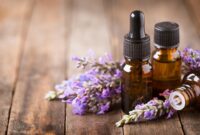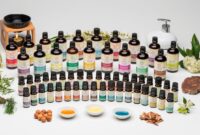Embark on a fragrant journey with aromatherapy tools, unlocking the transformative power of essential oils to elevate your mind, body, and spirit.
From the soothing ambiance of diffusers to the invigorating effects of inhalers, discover the myriad ways these tools can enrich your life.
Aromatherapy Tools
Aromatherapy is a holistic practice that utilizes aromatic compounds extracted from plants to enhance well-being. These compounds, known as essential oils, possess therapeutic properties that can be inhaled or applied topically to promote relaxation, alleviate stress, and address various physical and emotional ailments.
To harness the benefits of essential oils effectively, a range of specialized tools is employed. These tools facilitate the diffusion, dilution, and application of essential oils, ensuring their safe and effective use.
Types of Aromatherapy Tools
- Diffusers:Electric or ultrasonic devices that disperse essential oils into the air, creating an aromatic atmosphere. They come in various designs, including ultrasonic, nebulizing, and evaporative models.
- Inhalers:Personal devices that allow for direct inhalation of essential oils. They are commonly used for respiratory support and can be filled with a blend of oils tailored to specific needs.
- Roll-ons:Small, portable containers with a rollerball applicator. They contain essential oils diluted in a carrier oil, such as jojoba or coconut oil, for easy topical application.
- Sprays:Bottles equipped with a spray nozzle that dispense essential oils diluted in water or a carrier oil. They are convenient for room freshening, linen scenting, and localized application.
- Bath salts:Mineral salts infused with essential oils, designed to dissolve in bathwater and release their aromatic benefits. They promote relaxation, detoxification, and skin nourishment.
- Massage oils:Carrier oils blended with essential oils, used for therapeutic massage. They penetrate the skin, delivering the benefits of essential oils to deeper tissues.
- Compress:A cloth or gauze soaked in warm water infused with essential oils. It is applied to specific body areas to alleviate pain, reduce inflammation, or promote healing.
- Jewelry:Pendants or bracelets designed to hold a few drops of essential oil, allowing for personal aromatherapy throughout the day.
Types of Aromatherapy Tools

Aromatherapy involves the use of essential oils to promote well-being and address various health concerns. Different types of aromatherapy tools are employed to disperse essential oils into the air or apply them topically. Each tool offers unique advantages and is suitable for specific purposes.
Diffusers
Diffusers are devices that disperse essential oils into the air, creating an aromatic atmosphere. There are three main types of diffusers:
- Ultrasonic diffusers:These diffusers use ultrasonic vibrations to create a fine mist of essential oils and water, which is then dispersed into the air.
- Nebulizing diffusers:Nebulizing diffusers use a high-velocity stream of air to break down essential oils into tiny particles, creating a concentrated and powerful aroma.
- Evaporative diffusers:Evaporative diffusers rely on heat to evaporate essential oils, releasing their aroma into the air.
Inhalers
Inhalers are small, portable devices that allow you to inhale essential oils directly. They are convenient for use on the go and can provide quick relief for respiratory issues or emotional stress.
Personal Diffusers
Personal diffusers are small, wearable devices that disperse essential oils into the air around you. They are ideal for creating a personal aromatic environment and can be used in close quarters, such as in a car or at work.
Roll-Ons
Roll-ons are small, glass bottles with a roller ball applicator. They contain essential oils diluted in a carrier oil, such as jojoba or coconut oil. Roll-ons are applied topically to the skin, providing localized benefits and allowing for controlled dosage.
Essential Oil Burners and Candle Warmers
Essential oil burners and candle warmers are devices that use heat to release the aroma of essential oils. Essential oil burners use a tea light candle to heat a small dish containing water and essential oils, while candle warmers use a low-wattage bulb to gently heat a dish containing essential oils.
Choosing the Right Aromatherapy Tools

Selecting the appropriate aromatherapy tools is essential for maximizing the benefits and creating a tailored experience. Factors such as individual needs, room size, and desired intensity should be considered when choosing diffusers. Different tool types offer unique advantages and disadvantages, and understanding these variations can help you make an informed decision.
Types of Diffusers
Ultrasonic Diffusers:These diffusers use high-frequency vibrations to create a fine mist, releasing essential oils into the air. They are relatively quiet and easy to use, making them a popular choice for beginners. However, they may not be suitable for larger rooms or those seeking a strong aroma.
Nebulizing Diffusers:Nebulizing diffusers use a stream of air to break down essential oils into tiny particles, creating a powerful and concentrated aroma. They are ideal for large rooms and those seeking a more intense experience. However, they can be more expensive and require more maintenance than other types.
Heat Diffusers:Heat diffusers use heat to evaporate essential oils, releasing their fragrance into the air. They are relatively inexpensive and easy to use, but they can alter the chemical composition of the oils, potentially reducing their therapeutic benefits.
Choosing the Right Diffuser
- Room Size:Consider the size of the room where you will be using the diffuser. Larger rooms require diffusers with a higher output to ensure adequate fragrance distribution.
- Desired Intensity:Determine the desired intensity of the aroma. Nebulizing diffusers offer the strongest aroma, while ultrasonic diffusers provide a more subtle scent.
- Personal Preferences:Choose a diffuser that suits your personal preferences. Some people may prefer the quiet operation of ultrasonic diffusers, while others may appreciate the powerful aroma of nebulizing diffusers.
- Budget:Consider your budget when selecting a diffuser. Heat diffusers are generally the most affordable, while nebulizing diffusers are typically more expensive.
Using Aromatherapy Tools Effectively
To fully harness the benefits of aromatherapy, it’s essential to use your tools effectively. This involves understanding the proper techniques for diffusers, inhalers, and personal diffusers, as well as the art of creating synergistic essential oil blends.
Diffusers
- Choose the right diffuser:Consider the size of the room, desired coverage, and noise level.
- Use high-quality essential oils:Pure, undiluted oils ensure optimal benefits.
- Follow the recommended dosage:Overuse can be counterproductive and potentially harmful.
- Clean your diffuser regularly:This prevents bacteria buildup and ensures optimal performance.
- Experiment with different scents:Explore various oils and blends to find what resonates with you.
Inhalers and Personal Diffusers
- Carry your inhaler or personal diffuser:Keep it handy for quick relief or mood enhancement.
- Inhale deeply and slowly:Take 5-10 deep breaths, allowing the scent to penetrate your senses.
- Use short, intermittent bursts:Avoid continuous inhalation for extended periods.
- Choose scents that suit your needs:Calming scents for relaxation, energizing scents for focus.
- Respect others’ sensitivities:Be mindful of those around you who may be sensitive to scents.
Creating Effective Essential Oil Blends
- Start with a base oil:Carrier oils like jojoba, almond, or coconut oil dilute essential oils for safe topical use.
- Choose complementary scents:Combine oils with similar or complementary properties for a synergistic effect.
- Consider the desired outcome:Relaxation, energy, or specific therapeutic benefits.
- Follow recommended dilution ratios:Ensure safe and effective use, especially for topical applications.
- Experiment and adjust:Find the perfect balance of scents and dilution for your individual needs.
Aromatherapy Tools for Specific Purposes

Aromatherapy tools can be used for a variety of therapeutic purposes, including relaxation, sleep, focus, and more. Different essential oil blends are suitable for different needs, and aromatherapy tools can be used in various settings, such as the home, office, or spa.
Relaxation
Aromatherapy tools can be used to create a relaxing atmosphere. Some essential oil blends that are known to promote relaxation include lavender, chamomile, and ylang-ylang. These oils can be diffused into the air using a diffuser or added to a bath or shower.
Sleep
Aromatherapy tools can also be used to improve sleep. Some essential oil blends that are known to promote sleep include lavender, valerian root, and chamomile. These oils can be diffused into the air using a diffuser or applied to the skin before bed.
Focus
Aromatherapy tools can also be used to improve focus and concentration. Some essential oil blends that are known to promote focus include rosemary, peppermint, and lemon. These oils can be diffused into the air using a diffuser or applied to the temples or wrists.
Other Therapeutic Purposes
Aromatherapy tools can also be used for a variety of other therapeutic purposes, such as reducing stress, relieving headaches, and boosting the immune system. The specific essential oil blends that are used will vary depending on the desired outcome.
Using Aromatherapy Tools in Various Settings
Aromatherapy tools can be used in a variety of settings, including the home, office, or spa. In the home, aromatherapy tools can be used to create a relaxing atmosphere, improve sleep, or focus on work or study. In the office, aromatherapy tools can be used to reduce stress, improve focus, and boost morale.
In a spa, aromatherapy tools can be used to create a relaxing and rejuvenating experience.
Safety Considerations with Aromatherapy Tools

Aromatherapy tools are generally safe when used properly, but it’s essential to exercise caution and follow specific safety guidelines to avoid potential risks. Understanding these safety considerations ensures the safe and enjoyable use of aromatherapy tools.
Essential oils, the primary ingredients used in aromatherapy, are highly concentrated and can cause adverse reactions if not handled correctly. Proper storage and handling are crucial to maintain their potency and prevent degradation or contamination.
Potential Risks and Precautions
- Skin irritation:Some essential oils, such as cinnamon and oregano, can irritate the skin, especially when applied undiluted. Always dilute essential oils with a carrier oil, such as jojoba or almond oil, before applying them topically.
- Allergic reactions:Certain essential oils, such as citrus oils and lavender, can cause allergic reactions in some individuals. It’s essential to perform a patch test before using any new essential oil on a larger area of skin.
- Ingestion:Essential oils are highly concentrated and should never be ingested. If swallowed, seek immediate medical attention.
- Eye contact:Essential oils can irritate the eyes. Avoid contact with the eyes, and if it occurs, flush the eyes thoroughly with water.
- Pregnancy and breastfeeding:Some essential oils, such as rosemary and sage, can be harmful to pregnant or breastfeeding women. Consult a healthcare professional before using essential oils during these periods.
Proper Storage and Handling, Aromatherapy tools
To maintain the integrity and safety of essential oils, proper storage and handling are essential:
- Store in a cool, dark place:Essential oils should be stored in airtight containers away from direct sunlight and heat to prevent degradation.
- Keep out of reach of children and pets:Essential oils can be toxic if ingested or applied to the skin undiluted.
- Dispose of properly:Dispose of expired or unwanted essential oils by mixing them with a carrier oil and discarding them in the trash.
Concluding Remarks

Whether seeking relaxation, focus, or therapeutic relief, aromatherapy tools empower you to harness the healing properties of nature. Embrace the transformative potential of these fragrant companions and elevate your well-being to new heights.
Q&A
What are the different types of aromatherapy diffusers?
Aromatherapy diffusers come in various types, including ultrasonic, nebulizing, and evaporative diffusers, each offering unique benefits and modes of operation.
How do I choose the right aromatherapy tool for my needs?
Consider factors such as room size, desired intensity, and personal preferences when selecting an aromatherapy tool. Diffusers offer versatility, while inhalers provide portability and personal use.
What are the safety precautions to consider when using aromatherapy tools?
Always follow manufacturer’s instructions, avoid using essential oils directly on the skin, and ensure proper ventilation to prevent potential risks.


